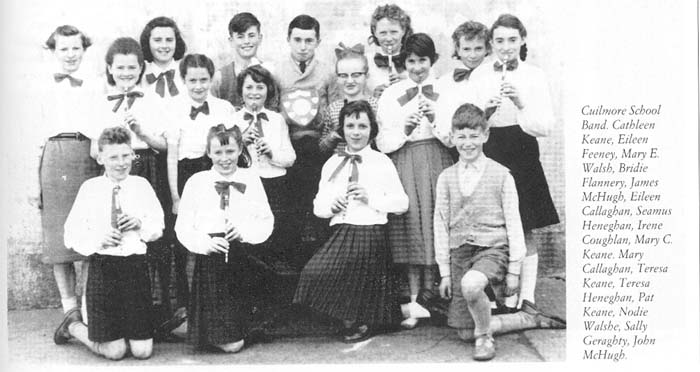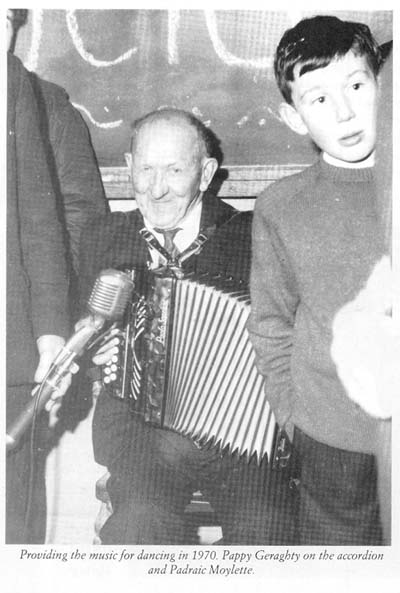
SET Dancing has its origins in the early 17th Century. Some say it was brought to Ireland by the British Army. The soldiers at night time parties would do the same movement to music as they did on the Barrack Square during training. The music they danced to was much slower than the present day music.
Even in those times of famine and oppression the Irish were on the look out for some lively night life, so they watched the soldiers at drills until they became familiar with the figures. Then they took it home in their heads and practised it in their own homes. They then adapted it to suit the Irish jigs, reels, hornpipes, slides and polkas.
Gradually over a period of seventy or eighty years set dancing became a purely Irish thing and nearly all traces of its British origins had disap- peared. Up till this time for the most part dancing was done to mouth music (now known as lilting) but from the introduction of the first few accordions it did not take long until there was a "3 stop single row melodeon" in every village.
Prior to all this, there was "Sean Nos Dancing" the oldest known form of Irish dancing. This was usually done by men on a door leaf or on the "hearth stone," a big flat flagstone in front of the fire. The man would dance most of the reel or jig and the lady would join him for the last 16 or 24 bars only, in case she would be considered over courageous or forward (my type) dancing.
At weddings, station dances, and American Wakes it was nearly all set dancing with the odd waltz and a little Sean Nos (Old Type) dancing.
By early 1950s set dancing was on the decline and by 1962 country house dances had completely died out.
It is said that set dancing in our area was taught by a Journey Man Dancing Master from Cavan in about 1860. I cannot say for sure if this is true. People who have done a lot of research on set dancing say that Mayo would have been one of the last places in Ireland that set dancing came to as we do not have the square dancing military style movements you will find in other parts of Ireland.

I remember as a boy going to Country House Dances in Cuilmore and Cortoon with my father and watching the sets being danced. It was a four part set, 2 jig parts, 1 polka, 1 reel and sometimes a slip jig. If there was a good many dancers only
2 parts of the set would be done -2 jigs and the polka. The reel would be danced towards the
end of the night mostly by the younger people because in the reel each gent got to dance with each lady in turn. This gave him the opportunity to ask a girl could he leave her home.
The sets were danced with great skill and style by the older people. This was easily acquired as they were watching sets from a very early age. The younger people danced with great vjgour and hilarity, with great whoops and yippies shouted during dancing. When it came to the "Long Polka" the musician would "lift the pace", the floor. would get the works with sparks flying and sometimes a cloud of ashes as some couple danced too near the fire, and someone would shout "Mind the Dresser."
There would be a quarter barrell of porter tapped down in the room. A few dozen porter glasses would be borrowed from the public house where the barrell was bought. If they ran short of glasses the porter would be drank out of cups, mugs, tinkers saucepans and enamel jugs.
As the night wore on there would be songs, not very many but mostly long lonesome songs about emigration (usually sung by people who never had to emigrate themselves).
The musicians were all local people. Some of them had peculiar ways of holding the melodeon. Jim Dever held it flat on his knees. Owen Keane stretched out his right leg and placed the melodeon down below his knee. A man from the half parish stretched back, closed his eyes while he was playing, you'd think he was fast asleep. Another man played very sweet music hardly moving the bellows at all. Then there was another man who would stretch out the bellows when playing you'd think he was going to pull it apart.
If you were walking up the path to a house where a dance was in session and listening to the music, you would easily recognise the musician as each musician had his or her own distinct style of playing.
The revival of set dancing began in the mid 1980's and by 1990 there were set dances in nearly every town, city and village. The main difference now is that dances have moved from the country houses to the community centre, halls, hotels and a few pubs.

At the present time, it would not be unusual to see people dancing a Cork or Clare set here in Mayo. Also the Derrada Set is very popular in Galway, Cork and Dublin.
I will close by saying that set dancing will be with us for many years as there is now, for the first time in thirty years, young people from the Cuilmore School area taking a very keen interest in set -dancing.